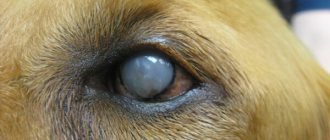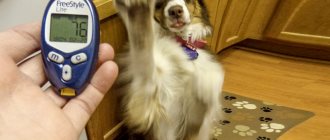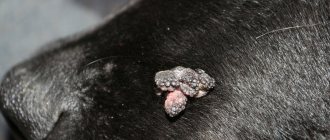What are dermatoses
Skin diseases in dogs, that is, dermatosis, is one of the most common ailments in pets. Their symptoms may be similar, but there can be many causes - from food allergies to parasites and autoimmune factors.
It should be remembered that in case of any alarming skin lesions in a dog, contact a veterinarian who will examine the animal, make a diagnosis and provide appropriate treatment, which will avoid complications that are unpleasant for both the dog and the owner.
Seborrhea
If the dog is healthy, then there is no dandruff on its skin or it is almost invisible.
Seborrhea can develop as a result of a disruption of the endocrine system, or be a consequence of sarcoptic mange. With seborrhea, the functioning of the sebaceous glands is disrupted, the skin becomes oily and many scales appear on it. The first foci of the disease appear in the lower abdomen and on the paws . The dandruff then spreads to the ears and tail, hocks and elbows, muzzle and chest.
There are two types of seborrhea:
- Dry. This type is characterized by dry skin, on which scaly, dry, crumbling dandruff forms.
- Fat. The disease is characterized by excess sebum, greasy scales clinging to the fur, brown patches on the skin and a rancid odor.
Dry seborrhea most often affects small sofa dogs, which are often bathed using various detergents. As a result, their skin becomes dehydrated and dry dandruff appears.
In some cases, the cause of dry seborrhea may be a lack of fat in the animal's diet. To get rid of dandruff, you can try including a teaspoon or dessert spoon of vegetable oil in your dog's diet, which it should eat daily. If after some time the dandruff does not disappear and the itching intensifies, then you need to consult a specialist.
As soon as, after testing, it is determined that seborrhea is not associated with parasites and fungi, it can be treated with antiseborrheic drugs . To do this, 1-2 times a week, the affected areas are treated with a special shampoo, which is left on the skin for 10 minutes and then washed off. After this, Pragmatar ointment or Thiomar cream is rubbed into well-dried skin. Until the cream or ointment is completely absorbed, it is recommended to hold the pet so that he does not lick it.
Since in some cases seborrhea is a consequence of a disease, the doctor prescribes medications to treat the underlying disease.
Types of skin diseases in dogs
About 30% of all visits to veterinary clinics are caused by dermatological problems. Therefore, this can be considered a general problem, but it should not be underestimated. Here are some of the most common skin diseases :
- Scabies
- Demodicosis
- Food allergies
- Cutaneous mycosis
- Atopic dermatitis
- Allergic dermatitis
- Idiopathic mucinosis
- Baldness (alopecia)
Let's take a closer look at all these diseases. We will also learn how to treat skin diseases in dogs.
Allergic diseases of dogs, skin allergies
An allergic reaction is the dog’s body’s resistance to the influence of allergens on it. Accompanied by the activation of histamine particles, the interaction of which with the blood provokes an inflammatory process. Reasons may include:
- Unhealthy diet or inhalation of an allergen. Incidents of skin diseases in dogs are becoming more frequent after an allergen is found in the food they eat or inhaled pollen.
- Directly allergens. Pets have contact with them throughout their lives. However, the first collision does not have negative consequences, while repeated contact can cause inflammation.
- Medicines. Using medications can be bad for your dog's skin. In particular, penicillin.
- Parasites. In addition to the obvious discomfort caused by blood-sucking insects to your furry friend, their bites can also cause allergies. The disease is well known as “summer dermatitis”. An allergic reaction can be determined by swelling in the bite area.
Allergies are quite unpredictable. Its appearance can be expected either immediately or within a couple of days after interaction with the irritant.
Summer dermatitis in dogs
Eczema or summer dermatitis, as the name implies, mainly makes itself felt at certain times of the year. But once a dog encounters this scourge, its return next spring cannot be avoided, and the animal will suffer from dermatitis until the onset of autumn. When the disease becomes chronic, pauses in the cold season cease.
This disease occurs spontaneously, affecting the body in 2-3 days. The dog's back and tail are the first to suffer: inflammation forms aching wounds. The dog itches and bites its teeth into the damaged areas, increasing the degree of threat to health, because when they are injured, there is a risk of bacteria getting inside, leading to secondary skin diseases in dogs.
Veterinarians do not advise treating a dog on their own, since the owner cannot know for certain what exactly caused the dermatitis, and therefore what treatment method is rational to use.
Weeping eczema
The disease spreads in a short time. The disease is often accompanied by bacterial infection. A dog with eczema tends to aggressively bite and tear the skin in affected areas. Symptoms include fever, enlarged lymph nodes, and vomiting. A wet, red bald spot becomes noticeable on your pet's body. Any touch to it causes unbearable pain to the animal.
Treatment should not be delayed under any circumstances, as this disease is painful for the dog. The cause of the disease is eliminated, a course of antibiotics, painkillers and a special diet are prescribed.
Acrodermatitis (“licked granuloma”)
A licking dog experiences a rush of endorphins. And if a dog lacks this hormone, it may systematically lick the same place on the body, which leads to thickening of the skin. When the dog continues to constantly lick the skin in this area, it turns red, abscesses appear, and tumors appear. These side effects are accompanied by itching, which again provokes licking. Also, as in the case of eczema, when a granuloma is licked, a bacterial infection may develop.
To achieve results in treatment, you should find out what caused the pet’s unusual behavior. Often the problem is psychological trauma, such as loneliness or resentment towards the owner.
Seborrhea
A common pathology is seborrhea. This is a disease expressed in failure of keratinization of the skin. It is clearly visible on the dog’s face, ears, neck and tail. Under the influence of the disease, too many scales form, the body begins to itch, emit an unpleasant odor, and the regulation of the sebaceous glands is disrupted.
You can get rid of seborrhea by using a complex of vitamins, corticosteroid drugs and amino acids, steroid hormones. A special soap will help cope with the smell and reduce flaking.
To relieve pain and relieve your pet from unbearable itching and burning, aloe juice is applied to the inflamed areas. You can prepare it yourself or purchase it at a pharmacy. Medicinal chamomile works on a similar principle. Baths with chamomile decoction will have a beneficial effect on the condition of a sick animal and relieve inflammation. Calendula and echinacea are also suitable.
If a once cheerful and active pet has become lethargic and sick, refuses its favorite food and games, constantly itches and licks itself, it should be seen by a doctor immediately. It’s better to do everything possible to prevent treatment: proper care, love and care will ensure the dog a long life.
Currently reading:
- Thyroid dysfunction in dogs (hypothyroidism)
- Seven Signs and Remedies for Getting Rid of Fleas in Dogs
- Is it worth it or not to include natural food in your dog’s diet?
- Actions to take in case of an epileptic attack and a shaking dog
Scabies
Scabies is a parasitic skin disease in dogs, but it can easily spread to humans. The dog shows visible symptoms in the form of skin lesions around the ears and mouth, as well as on the elbows and ankles. A characteristic symptom is severe itching, which can occur even before the appearance of skin lesions. You first notice erythema, then balding and scabs develop. Treatment is very difficult because all parasites must be killed and the skin is an ideal protective barrier for them. Before starting treatment, baths are necessary to help soften the skin and remove scabs, and then use antiparasitic drugs.
Prevention of skin diseases in dogs
Of course, you won’t be able to protect your pets from all misfortunes, but you can still significantly reduce the risk of infection. What can be done for this?
- provide the dog with adequate nutrition;
- during the off-season, in poor health and other situations, give your pet vitamin complexes;
- do not allow the dog to communicate with stray relatives;
- monitor the condition of the pet’s skin and general well-being;
- keep the dog clean, wash and brush its coat on time.
If you adhere to these simple rules, then you can completely protect your beloved pet from any misfortune, especially from skin ailments.
Categories: Veterinary |
by Male
Demodicosis
The disease is caused by Demodex canis infestation. It is also often called demodicosis. Parasites feed on hair follicles and cause inflammation. Over time, the fur begins to fall out, and the dog experiences severe discomfort and itching.
Demodicosis takes on a local form, which is characterized by a small number of skin lesions located mainly in the mouth and interdigital spaces. There is also a generalized form. It is said to occur when a dog has more than 12 lesions throughout its body or when the lesions are large in diameter.
Diagnosis and treatment are not always easy, since the parasites live in the hair follicles. It should be noted that Demodex occurs naturally on the skin of dogs, but in small quantities. An effective dog's immune system will prevent the development of parasites, which is why the disease primarily affects dogs whose immune system is weakened .
Immune disorders
If a dog suffers from any type of autoimmune or immunosuppressive syndrome or disorder, they may develop skin conditions that lead to back sores.
These skin disorders occur as a side effect of the fact that the dog's immune system is either compromised and it is unable to fight off harmful irritants, or because the immune system is overworked and attacks itself as a result.
These types of skin diseases are among the most serious types and can lead to death.
© shutterstock
Food allergies
Very often, various skin lesions in dogs are symptoms of food allergies - then they can be observed mainly around the head, ears, chest and forelimbs. The animal feels severe itching and may have seborrhea, recurrent pyoderma, and urticaria.
Scratching and licking itchy areas can lead to baldness and sores. Treatment of skin symptoms of food allergies involves the timely administration of an anti-dental agent, and then the start of an elimination diet, that is, feeding food with a single source of protein - usually turkey, rabbit or kangaroo meat. After twelve weeks, you can try introducing a new protein - always after consultation with a veterinarian, and preferably also with an animal nutritionist.
Prevention
A series of preventive measures will allow you to prevent a sore from appearing on your dog’s face. They are simple and won't take much time to complete.
- Properly care for your pet: provide it with adequate nutrition, access to water and a regular walking schedule.
- In case of contact with sick or stray animals, the dog should be examined and bathed with special anti-parasitic agents. It will protect against skin mites.
- Vaccinate your pet in a timely manner, especially if he participates in exhibitions.
- Periodically disinfect the bed and places that the animal constantly visits: a bowl, a drinking bowl, a favorite sofa.
Whatever the reason for the appearance of sores, if they remain on the face for a long time and do not heal, it is best not to overuse home treatment, but to turn to professionals. Believe me, your case is not the only one; an experienced veterinarian has experience in treating them.
Cutaneous mycosis
Cutaneous mycosis is a common condition that causes easily noticeable changes on your dog's skin. The changes are expressed in the form of alopecia, which have a semicircular or round shape. There may also be scabies. The disease primarily affects older dogs or those with weakened immune systems.
Treatment involves the use of medications within the skin lesion or systemically if mycosis is severe. In addition, the animal’s immune system should be strengthened at the same time. There may also be deep mycoses, which are treated in general. Therapy is long and complex, and traces of the disease remain on the skin.
DEMODECOSIS - skin diseases in cats and dogs
Demodex is a parasitosis that occurs as a result of an increased population of Demodex mites in the skin. In adult animals, the problem can arise due to disturbances in the functioning of the immune system (oncological, hormonal), and when using drugs that reduce the immune response (steroid hormones, chemotherapy). Juvenile demodicosis is often observed in young animals. It usually occurs before one year of age and is caused by a hereditary defect in the immune system, causing it to become unable to control the number of mites. In this case, the number of mites increases and they begin to cause disease. The first signs of the disease are usually alopecia - bald spots, most often in the head and paws. Treatment of demodicosis is carried out using various methods; the choice of method depends on the breed and age of the animal. However, localized demodicosis, when the animal has less than 5 small lesions, less than 2 cm in diameter, does not require treatment at all and goes away on its own. It is important to understand that since generalized juvenile demodicosis is a hereditary disease, a dog that has had it cannot be used for breeding even after complete recovery. A dog is considered recovered from juvenile generalized demodicosis if it does not have a relapse within a year. Treatment of generalized demodicosis, regardless of the method used, usually lasts quite a long time, usually several months in a row, and can be stopped only after 2 series of scrapings with an interval of a month do not reveal a single mite, either live or dead Treatment may take 3-6 months or sometimes longer.
Atopic dermatitis
Atopic dermatitis is a chronic condition with a tendency to relapse. Its typical features are persistent itching, very characteristic skin lesions and the location of these lesions.
Dog breeds that have the greatest tendency towards atopy include: West Highland White Terrier, Cairn Terrier, Golden Retriever, Labrador, Dalmatian, Irish Setter, Boxer, Chow Chow and Shar Pei.
Atopic dermatitis is an allergic reaction most often caused by various types of detergents, cleaning products, insect bites and external parasites - fleas and sometimes mites - living on the skin.
Additionally, different types of pollen or food allergies can cause an unpleasant reaction for your pet. Symptoms of atopy are usually erythema and itching, which are irritating to the dog. The animal licks and bites the affected areas, which leads to secondary infections and skin lesions in the dog. Conjunctivitis may also occur. There is no cure for atopic dermatitis; the goal of treatment is to improve the animal’s quality of life. It involves removing allergens from the dog’s environment.
External parasites
Fleas.
They are external parasites that most often irritate a dog's skin, causing the dog to excessively lick, scratch and/or chew the skin, leading to back sores. Some dogs are much more sensitive to fleas than others. You may not be able to see a single flea on your dog, but that in no way means there are not lurking on your dog, in his fur, in your carpets and/or in your yard.
Severe cases of flea infestation can lead to excessive blood loss, leading to anemia, as well as other parasites in the dog, like tapeworms. Proper flea prevention and control is a must for all dogs.
Ticks.
These are external parasites that attach to a dog's skin and feed on their blood, causing skin irritation, itching, ulcers and sores, including on the back. Dog owners can of course see a tick feeding on their dog with the naked eye and can remove it themselves by grasping the tick with tweezers positioned as close to the dog's skin as possible and gently pulling the tick straight from the skin.
Idiopathic mucinosis
Accumulation of mucin, that is, hyaluronic acid, proteoglycans and chondroitin sulfate. The symptom is excessively wrinkled skin or the formation of tiny blisters with a sticky discharge on the surface. Mucin accumulates abundantly most often in the hind legs and abdomen - this is where symptoms are usually most pronounced. Treatment is based on symptom relief. The disease may recur. Shar-Pei dogs are most often affected by this type of canine skin disease.
Diagnostics
At an appointment with a veterinarian, you will have to describe in detail the dog's lifestyle , its food preferences, the diseases it has suffered, as well as the symptoms of this disease from the beginning of their onset. To find out the cause of the disease, the attending physician will conduct several tests. There are many different possibilities as to why the skin reacts this way, so the examination will be very thorough. The search begins, of course, with a detailed external examination of the animal. If something seems suspicious to the veterinarian, he will order additional tests.
In any case, you will have to take a complete blood test of the dog, a biochemical profile, and a urine test . Often, the results of these tests show that the body is fine, unless your pet has a blood disorder such as hyperthyroidism, a bacterial infection, a fungal infection, or cancer.
To assess the condition of the skin, the following procedures may be necessary:
- A skin scraping that will be sent to the laboratory to be tested for fungal and bacterial infections
- Skin biopsy
- Skin tests to identify possible allergens
- Testing for ectoparasites (skin parasites)
- It is possible to prescribe a hypoallergenic diet if the veterinarian suspects an allergic reaction to any food











